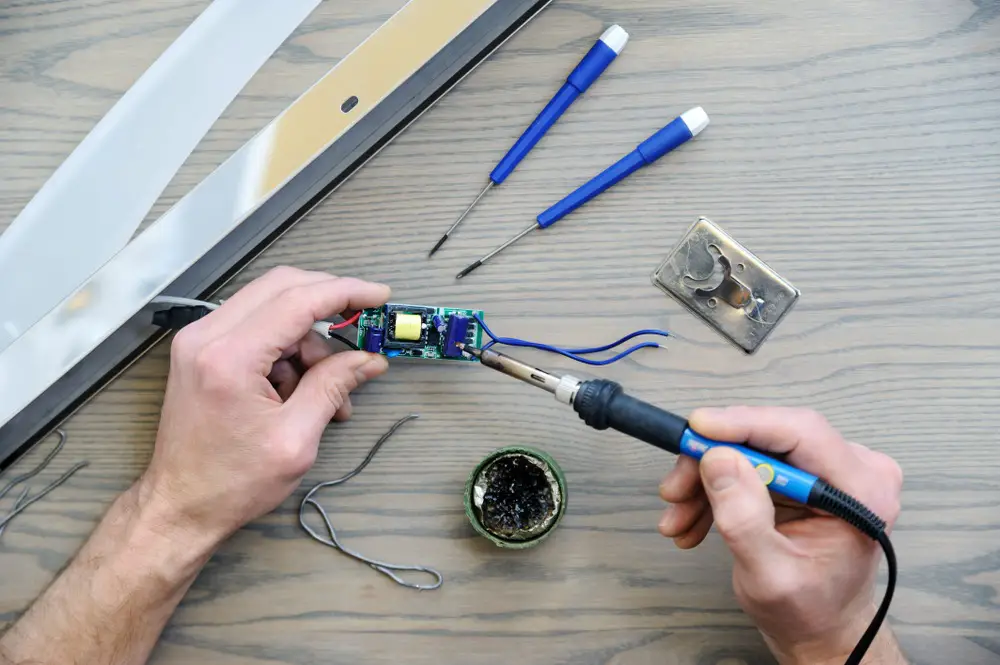A soldering iron is a tool used for soldering components by transferring heat from a metal tip to wires, pads on PCBs, and transistor leads. It consists of an insulated handle and a heated metal tip. Heating is achieved by passing an electric current through batteries or electrical cord via a resistive heating element.
Once the surface is adequately heated, solder is applied. There are two types of soldering irons: cordless (gas or a battery-powered) and corded irons. The cordless irons are heated through the combustion of butane gas using a catalytic heater.
Corded irons use electricity to function. Soldering irons are used for a range of applications, including making repairs, installation, joining electric components, to mention a few. Most electrical applications need soldering irons with a wattage of 25-40 watts, but larger jobs need devices with a higher wattage.
Note soldering irons with high wattage are not necessarily hotter; they are just designed to heat larger components. For example, a 40-Watt soldering iron creates joints faster than a 25-watt iron. As such, it is ideal for joining large sheet metal objects.
Core Components
Solder
As stated earlier, the irons use solder to attach the electrical components. Solder is a thin tube made of soft metal alloys and is usually rolled in spools. Most solder types have a high percentage of tin and a low percentage of a soft metal, e.g., a 60/40 ratio.
Tin is a soft metal, but it makes strong bonds between the workpieces. However, since lead was declared a toxic element, modern solder is now lead-free. It has a high melting temperature but has less wettability, i.e., you need a high-end soldering iron to use it, and it is tedious to remove it.
Flux
Another component of solder is flux, which is a chemical agent available in gel form and functions as a catalyst for solders. Flux transfers heat from the iron to the metal, helping the solder to create a chemical bond with the metal.
It also removes the oxidation layer and cleans the surface when heating the components. Most solders contain flux, also called core solders. Users can also purchase flux from a hardware store and add it to the solder when heating surfaces. There are different types of solders, each designed for various soldering applications.
Rosin-core or rosin-flux solder, for example, is ideal for electrical soldering jobs while acid-flux is used for plumbing as the acid can easily damage the sensitive parts on circuit boards.
Types of Soldering Irons
There are five types of soldering irons: temperature-controlled irons, cordless irons, pencil irons, torches, and soldering stations. Stations, pencil irons, temp-controlled irons, and cordless irons use a high resistance electrical current that heats the tip. The heat then melts the solder to bond the workpieces.
The main difference between these four types of irons lies in functionality and user interaction. Soldering torches are slightly different in that they are not suitable for most basic soldering jobs because they produce a lot of heat. Thus, they are often used for brazing and soldering hard metals.
How to Use a Soldering Iron
You first need to determine the appropriate temperature for the project. The temperature depends on two factors: the materials being joined and the type of solder used. The best temperature should be low enough not to burn the components and high enough to get the task done. As such, if the required temperature is 370 F and above, set the iron at a temperature of 370.
Once the iron has attained the appropriate temperature, hold the iron by one hand and the solder in the other. Then, place the iron where the two metal components meet for one second. The idea is to heat the metal parts not the solder
Then allow the solder to touch the heated components. If the components are hot enough, the solder should melt flowing into the gaps it needs to fill. Feed the solder on to the elements until a sufficient amount melts. You don’t want too much solder on the components
Allow the solder to cool and check the joint for quality. A firm connection should be smooth, shiny, and uniform. Ensure there are no gaps between the components or lumps of excess solder

